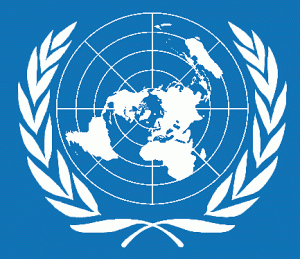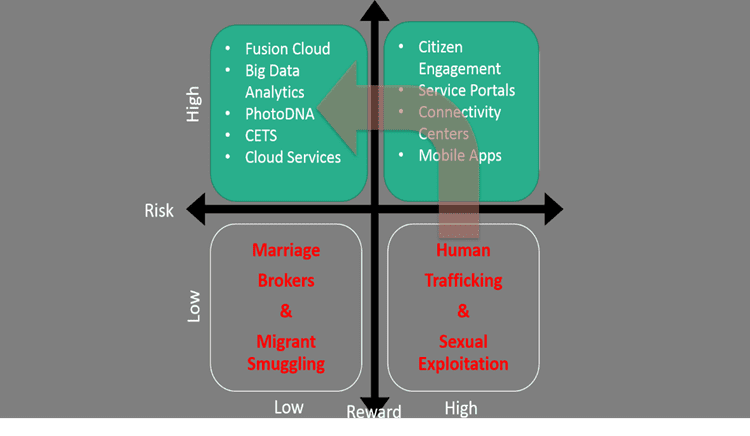The IT arsenal available to us in the fight against human trafficking

Human trafficking is a global problem that has ensnared more than 25 million people around the world. The crime represents a classic asymmetric threat: small, ill-armed organizations evade national law enforcement efforts and circumvent national and international laws. This is in part because of the officials charged with enforcing the laws are often untrained and ill equipped, and in part because traffickers use modern technology that enables real time, anonymous communication and collaboration.
Successfully combating these criminals requires mobilizing the Communities of Interest against them, creating a legal and operational framework that enables cooperation across jurisdictions and among criminal justice systems. It also requires empowering these communities through the use of information technologies to not only level the playing field with traffickers, but to give law enforcement the advantage, altering the risk-benefit equation for this sinister trade so that it is no longer a viable business.
“Disruptive technologies” can play an important role in shifting the dynamics of the trafficking trade. Technology can not only improve law enforcement efficiency, it also can democratize the process of combating traffickers, providing all participants with an equal voice, tying individual emotions and public sentiment to the issues, and enabling more active participation by everyone.
Altering the Risk-Reward Environment
While it might not be possible to completely eliminate human trafficking, it is possible to increase the risks so that the profits from the trade are become less attractive. In a chart of relative risk and reward, traffickers now are operating in the low risk-high reward quadrant, the optimal location for any business undertaking.

Our goal in combating human trafficking should be to force traffickers into those regions where risk is increased and profitability is reduced.
There are many reasons why the risk is so low for these highly rewarded profiteers. Victims and their families often do not cooperate with law enforcement in many countries. They may live near the traffickers and may be threatened or intimidated by them. Some countries lack the law enforcement procedures, anti-trafficking legislation, legal penalties, and evidentiary practices needed for meaningful prosecutions. Law enforcement officials and prosecutors often lack training and resources. Without the systems needed for evidentiary support, case management and other support, investigations and prosecution are difficult.
We can increase the risk for these criminals by mobilizing the forces opposed to trafficking and seeing that they have the information technology needed to fight this crime at the local, national, and international levels. Through cooperative efforts that raise the costs, risks, and difficulty of doing business for traffickers, we can make human trafficking a less appealing trade.
The Technology Solution Space
Technology companies can address human trafficking by providing software tools that build citizen awareness to prevent recruitment and abduction. They can encourage civil engagement through the funding of development efforts to combat this global ill. Mobilizing the development community through events such as Anti-Trafficking Hackathons, or investing in technology partners with the skills and interest to tackle this problem, can foster rapid creation and deployment of needed tools to improve civic engagement.
For the law enforcement side, the IT community can:
- Deploy software solutions that take inputs from a vast global network of mobile sensors and the Internet of Things;
- Use Big Data solutions to harvest relevant information from multiple sources including Open Data;
- Monitor the social media networks in public domains that are used by traffickers;
- Apply state-of-the-art geospatial and other analytical tools to the information they gather; and,
- Institute information-sharing arrangements and tools among their partner agencies and organizations.
These technologies can disrupt the human-trafficking supply chain, making it more difficult for traffickers to recruit, abduct, transport, and sell their precious cargo; further investigations and help gather evidence; and improve cooperation. The technology solution space is increasingly relevant in tackling the challenges of human trafficking, providing a range of necessary capabilities:
- Interagency Situational Awareness, Information Management and Analysis: Effective interagency information sharing to achieve a common operating picture is necessary for focused, well-coordinated interagency response and interdiction efforts. This requires software for gathering, investigating, managing, and analyzing information, and to enable sharing, collaboration, and secure communication within and between organizations.
- Case Management: Organizations must collaborate and share information with hundreds of independent entities at both the programmatic and individual case level. Familiar, pervasive, and collaborative workspaces and portals help enable people and organizations to work together more effectively.
- Coordinating Needs with Offers & Services Portals: Technology is a mechanism for creating a market of willing donors of information and resources. Public-facing portals and back-end management applications can publicize an agency’s needs, and can make available services enabling software developers and citizens provide those needs.
- Connectivity Centers: Intergovernmental and nongovernmental agencies engaged against trafficking often lack command and control facilities and emergency operations centers. Connectivity centers co-located with “halfway houses” or shelters can provide a lifeline for trafficked persons to reconnect with families and assist their rehabilitation and reintegration.
- Public Communications and Response: Increasingly, organizations combating human trafficking are partnering with citizens and communities to collect information and assist in remediation efforts. Mobile technology applications let community members play an active role in responding to human trafficking-reporting, assisting in victim recovery, and prevention.
- Cloud Computing: Cloud services bypass the need for robust local IT infrastructure and empower personnel with innovative technologies, smarter applications, security-enhanced unified communications, and more powerful collaboration.
In an upcoming post I will illustrate the way technology can be applied to combat human trafficking, from assisting governmental and nongovernmental agencies to protecting young or inexperienced users and keeping them safe online. And, stay tuned for more information about our June 23-24 event in Bangkok, presented with the United Nations, about the united effort to stop exploitation through human trafficking.




